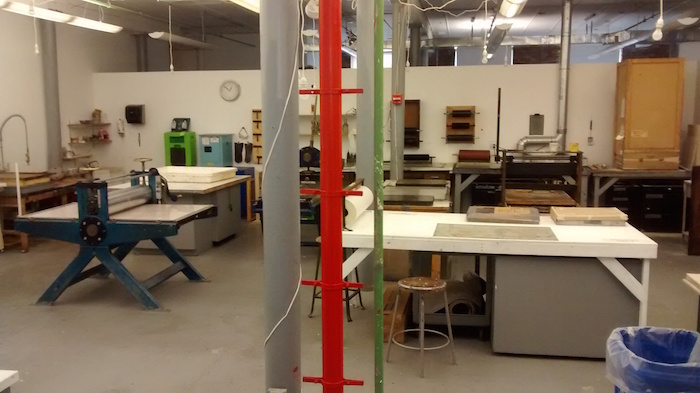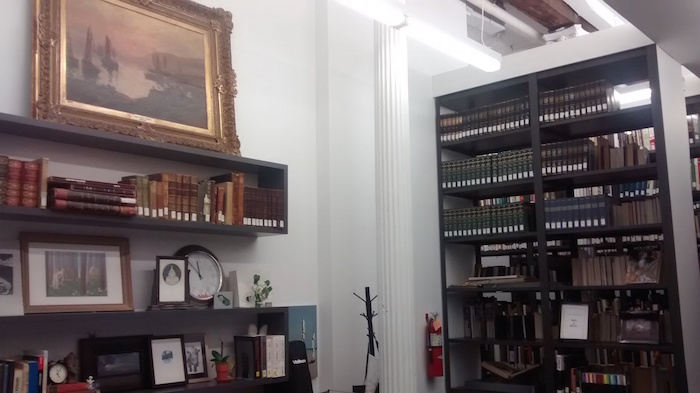Peter Drake, Dean at the New York Academy of Art Interviewed by Matthew Klos
I met with Peter Drake, Dean of Academic Affairs at the New York Academy of Art (NYAA) on a beautiful, oddly chilly late summer day in New York City. Our discussion included his views on NYAA’s unique offerings to students, the experience of studying art in NYC, and the atelier movement versus the pluralist model at most art schools. He also shared his opinions on what it takes to be successful in the art world today.
New York Academy of Art has a star studded roster of full-time faculty and visiting critics including you. The visiting critics include Jenny Saville, Eric Fischl, Judy Fox, Will Cotton, Vincent Desiderio, Steven Assael, and the list goes on. How important in the formation of young talent is studying in New York and exposure to artists of that caliber?
I think that, just as you know in your own experience as an academic, that you sort of need to have people who are doing the heavy lifting, the stuff that just keeps the school going, and you need to have names that draw students in but also serve as models to the students themselves.
For me at the Academy the most important thing is to strike a balance between artists that are delivering master classes, which is kind of a weekend class which reflects their studio practice, and the people who are delivering course content on an everyday basis and those are our adjuncts and our full time faculty. That mixture for me has become really powerful here. I think it’s something that makes the curriculum fresh because you are bringing in new voices all the time and you’ve got this core of dedicated artists and academics that are the face of the academy that deliver the content and the curriculum.
Clearly things have shifted somewhat in terms of New York being the epicenter of the art world as it once was in the Modern era. Can you describe some shifts that you’ve seen or what your feelings are about that?
It’s become a real challenge. Up until, I believe it was the 70’s, it was relatively easy for an artist to live and work in New York City. You could get huge lofts and storefront spaces and you just didn’t have to work as hard to keep your head above water. New York now has become a real challenge especially for younger and emerging artists just to find studio and to find cheap enough spaces to live so they’re not working 24/7 just to pay their bills. So that is a huge shift, definitely.
Obviously the internet provides access to global art universally at this point so you can be a sophisticated artist and be aware of the larger art world living more or less anywhere. As a contradiction to that I think it’s still true that being near one of the major hubs is a really important experience. I feel like here in New York still you’ve got this incredible array of museums like the Met, the Modern, the Guggenheim, the Frick, the Morgan Library, but you’ve also have the nonprofits. You’ve got Artist Space, Drawing Center, White Columns, those things are a source of inspiration for people. So, if somebody comes to New York for their education they are being educated obviously inside of their institution but they are also being educated by the city itself.
I like to think that this is a city where it is next to impossible to be bored and that’s a really important feature. Even for me, every so often, you get to this point where you are stalled in the studio and maybe you go up to the Hispanic Society to see the Sorolla’s or you go to the galleries in Bushwick or Williamsburg or the Lower East Side to see something you haven’t been exposed to before and it just recharges you. Even from here in Tribeca you walk two minutes and you are at the Postmasters Gallery. You walk five blocks north and you are at Artists Space or Apexart. It’s phenomenally easy to get inspired here.
NYAA has been known for producing highly skilled painters. Andy Warhol and others founded the school in 1982 because they felt a classical training in drawing, painting, and sculpture was essential to the contemporary artist. In Baltimore and among other regions, home and abroad, it seems that a return to the classical atelier type instruction is seeing a resurgence. How does the highly skilled craft of painting being taught at NYAA differ from what we might call the atelier movement?
That’s a really important distinction and I’m glad you brought it up. I feel like there are two problems in art education right now. On the one end you’ve got the atelier system which is largely focused just on technical development and it’s usually just technical development framed by a single artist entity. Like they are usually advocates of a particular artist’s style. On the other end you’ve got the pluralist model which most art schools–Parsons, Pratt, SVA–offer to their students, which is I think a broad array of points of view which you could argue is the best reflection of the art world. Unfortunately it also creates a kind of jack-of-all-trades/ master of none environment.
I think that’s really problematic. You go to a school and you get exposed to a lot of things but you can easily come out of an education from one of those schools and have no idea how to paint or draw or sculpt and that’s what we are trying to fix here. We are trying to give people the technical skills that they need to realize their artistic vision but at the same time placing that in a contemporary context.
The worst case scenario, and you see this in some of the atelier websites, you go to the website and you see that every drawing, every painting, every sculpture, looks like it was made by the same person. There is absolutely no sense of individuation. On the flip site you go to the pluralist models website and you tend to see almost no art. There is very little on their pages that is a reflection of the work that is done there. That is a red flag.
It seems that the world of contemporary painters can be divided between those who are intrinsically connected, even enamored, by the materiality of paint and those who use paint to move an idea to the viewer. Obviously both groups manifest images but the former would despair without paint while the latter would abandon it if a better conduit for their artistic expression was available. Are you a paintophile a visual ideator or something in between?
This is a really interesting question for me because it’s something I think about a lot and it’s something that I was very aware of when I was an art student myself. I actually break it down into the very obvious polemic of the Romantics and the Classicists.
The Romantics tend to be the paint lovers, the people who throw themselves into the immediacy of painting and materiality of painting, and that’s a really beautiful thing and fantastic work can come from that but I also think there are mythologies that adhere to it that have been a kind of weight or lead anchor in the art world for a long time because they suggest that you can only find deep emotional content and immediacy in the painterly and open form painting. For me a Holbein is every bit as beautiful and evocative and emotionally charged as a Rubens or a Frans Hals. The myth also implies that closed form rendering or conceptual painting isn’t in and of itself an emotionally charged form of art making.
I think there are also problems with the Classical model too since it can focus so much on conceptual content that it doesn’t apply itself to materiality, it doesn’t allow itself to engage in a love of material, a love of process. So frequently you see artists in a kind of post studio practice. People hire other people to facilitate their work. Those people are making the most extreme form of this classicism where it is a purely cerebral operation and that model of studio practice for me is really disheartening. It feels soulless. You look at the Koons model and he’s got 70-100 people working for him at all times and those people are rendering his work almost mechanically. When you see the work you sense that any kind of emotional content, any kind of real attachment to process, has been obliterated.
So how do you see that differing with someone like William Beckman and his work and studio practice?
Beckman is still a single combat warrior. He’s the guy that does everything but he does it in an intense and maybe emotionally aloof way. In some ways you could say that the actual end result can feel a little bit removed. I think that because he’s there every day and because he’s so invested in it that somehow it gets imbued into the work and you feel a sort of magical pull of his work when you are in front of one of those pieces.
So it’s something about the authorship?
Yeah! Maybe there’s a bit of magical thinking on my part when it comes to things like that but I still think that some of the most powerful components of art making are the magical and inexplicable.
What advice would you give to a young artist who hopes to be successful in the art world of, say, the 2020’s or 30’s. What place in the art world will figurative drawing, painting, and sculpture have 20 years from now whether it be from observation or from other visual sources?
Well, for me, there are two questions there. The first one is sort of the career advice and the model that I always use is that if a table has ten legs and you pull one of them out it still stands. So if you are an artist and your career is your table you need to have ten legs. You need to be thinking about working with the marketplace, the galleries, but you should be thinking about reaching out to non-profits and small museums. You need to be working with consultants, designers, architects.
I always tell sculpture students in particular that architects will become your best friends. Those are the people that are going to be commissioning pieces from you and are going to be able to bring 3D clients to you. You also have to be thinking in terms of printmaking. You have to think about how drawing, printmaking, and painting have basically different audiences. All these things are different legs in somebodies career. Teaching, lecturing, writing, working as a critic, thinking of yourself as a curator. All of those things can sustain your life as an artist and it is important to have as many of them under your table as you possibly can because inevitably one of them is going to dry up from time to time and once that leg is taken out and you only have three legs you’re screwed. I have taught full time for eight years at Anne Arundel Community College just outside of Annapolis MD and every serious art student I come across is apprehensive about the cost of pursuing a BFA degree let alone moving in the direction of an MFA. What do you tell prospective students when they consider the payoff versus the cost of an MFA at NYAA?
I have taught full time for eight years at Anne Arundel Community College just outside of Annapolis MD and every serious art student I come across is apprehensive about the cost of pursuing a BFA degree let alone moving in the direction of an MFA. What do you tell prospective students when they consider the payoff versus the cost of an MFA at NYAA?
I will speak specifically about the academy because I think the academy offers some things that other schools don’t. One that is really important is a kind of supercharged emergence into the artworld because we have development events here like “Take Home a Nude” and “Tribeca Ball” that expose our students the collecting community in New York… the collecting, curating, and critical communities in New York. You come to “Tribeca Ball” and it’s five floors of just craziness; people looking at art, buying art, going into students studios, making connections, and we have students who come out of the program every year entering into the art world immediately because they have been exposed to these people.
For example, someone like Moses Tuki, who’s got this piece that is being presented at Art Southampton, opening tonight actually, and it’s a piece that was shown in our lobby during the MFA thesis show. A collector came in, fell in love with it – Moses was charging $30,000 for the piece but he was donating the proceeds, if the piece sold, back to the Academy so we could develop a residency program in his native Nigeria. When the collector heard this he said, “Well, I won’t pay $30,000 but I will pay $60,000 so the artist can get $30,000 and the school can get $30,000.” Now the piece is being show in Art Southampton and people are going crazy for it.
We really focus on trying to get people out into the world and to supercharge their careers while at the same time building a community here. One they can rely on. You go to Bushwick now and go to the Troutman studios and there are like forty graduates there all working together and aware of each other. It’s kind of a phenomenal experience.
Some tremendous success. Do you feel that’s usual, (would you say that) fifty percent, twenty percent, ten percent (have that experience. Maybe it’s difficult to break it down to those sorts of numbers.
It really is. To be successful is different for each artist. We’ve got students that are curating shows and writing criticism. My hope is that over time they will all become full time participants in the art world. That really means creating a community and sustaining yourself through your community, helping your community and that’s the thing that we really try to build here. You talk to any arts administrator and they always talk about community but we really make an effort to sustain that.
To learn more about Peter Drake’s works, writings, and curatorial projects visit his website http://peterdrakeartist.tumblr.com.
Author Matthew Klos is a perceptual painter, curator, and a professor at Anne Arundel Community College.












